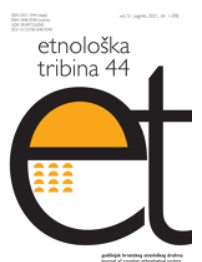Forest, forest, forest. Sometimes we sleep. Walking, sleep, walking, sleep. It’s dangerous on this way. Weaponized Migration Landscapes at the Outskirts of the European Union
Forest, forest, forest. Sometimes we sleep. Walking, sleep, walking, sleep. It’s dangerous on this way. Weaponized Migration Landscapes at the Outskirts of the European Union
Author(s): Marijana Hameršak, Iva PlešeContributor(s): Juraj Šutej (Translator)
Subject(s): Studies in violence and power, Environmental interactions, Migration Studies, Ethnic Minorities Studies, Asylum, Refugees, Migration as Policy-fields
Published by: Hrvatsko etnološko društvo
Keywords: forests; refugees; migrants; weaponized landscapes; pushback; Croatia; European border regime;
Summary/Abstract: Hidden migrant routes through Croatia lead through forest areas (among other types of terrain) which include those along state borders, but also forests in the interior of the territory. Those forests can variously be seen as shelters for migrants, albeit harsh, or as green tunnels leading to desired destinations, and as scenes of suffering and violence. This article approaches the forests in question as landscapes that have been transformed from a neutral natural environment into active factors for creating and maintaining border control regimes and deterring and expelling unwanted migrants. Based on our long-term field research and publicly available (archival, media and other) sources, we seek to document, interpret, and interconnect the objects and practices involved in constructing the forest as a hostile terrain and perilous environment for migrants, and as an important element in controlling unwanted migrations. These are, on the one hand, objects and practices that intervene into forests, such as setting up cameras or cutting down trees, and, on the other, interventions that take place in forests, such as police interception or expulsion. Apart from these external interventions, in this context of remodeling forests into dangerous environments, one can also discuss the role of nature itself and its characteristics, as well as the causes of why migrants find themselves in nature in the first place. Although, at first glance, it seems that people on the move choose the forest as the place and route of their movement of their own volition, they are pushed and expelled into these forests by exclusionary policies (visa regimes, asylum systems, etc.). This, ultimately, classifies forests in Croatia as weaponized landscapes of exclusion and death, such as the desert (e.g., De León 2015), mountain (Del Biaggio et al. 2020), maritime (e.g., Albahari 2015) or archipelago (Mountz 2017) landscapes.
Journal: Etnološka tribina : Godišnjak Hrvatskog etnološkog društva
- Issue Year: 51/2021
- Issue No: 44
- Page Range: 204-221
- Page Count: 18
- Language: English

